Research
Our research program focuses on understanding the nature of dark matter and dark energy. We pursue this via new observations of the universe using existing facilities, though development of new facilities and instrumentation, and a laboratory search for dark photon dark matter. The current focus of our group is the Rubin Observatory's Legacy Survey of Space and Time (LSST). We are completing construction of the observatory in Chile and at labs in the US, and transitioning to operations. We collaborate with others in the LSST Project and the LSST Science Collaborations.
A key focus of our research activity is optimizing LSST performance. For this, we study and charaterize the CCDs used in the LSST 3.2 gigapixel LSST Camera in our lab at UC Davis. We also use the DLS data and Subaru HSC data to develop new data analysis algorithms required for LSST. One area of our research is improved photometric redshift calibration. We also have laboratory experiments to measure systematic errors in the LSST CCDs, and develop an understanding of the 3-D electron transport effects, leading to a correction that can be applied in the LSST data software pipeline.
LSST CCDs put to the Test
Experiments usually are limited by systematic errors, sometimes due to sample selection bias, and sometimes due to systematics in the detector. Our LSST CCDs are novel segmented thick 3-D devices, and the charge transport in these thick silicon CCDs is complex. In order to map these effects, we have built a LSST optical beam simulator, which allows us to operate the CCDs in a realistic f/1.2 beam illumination.
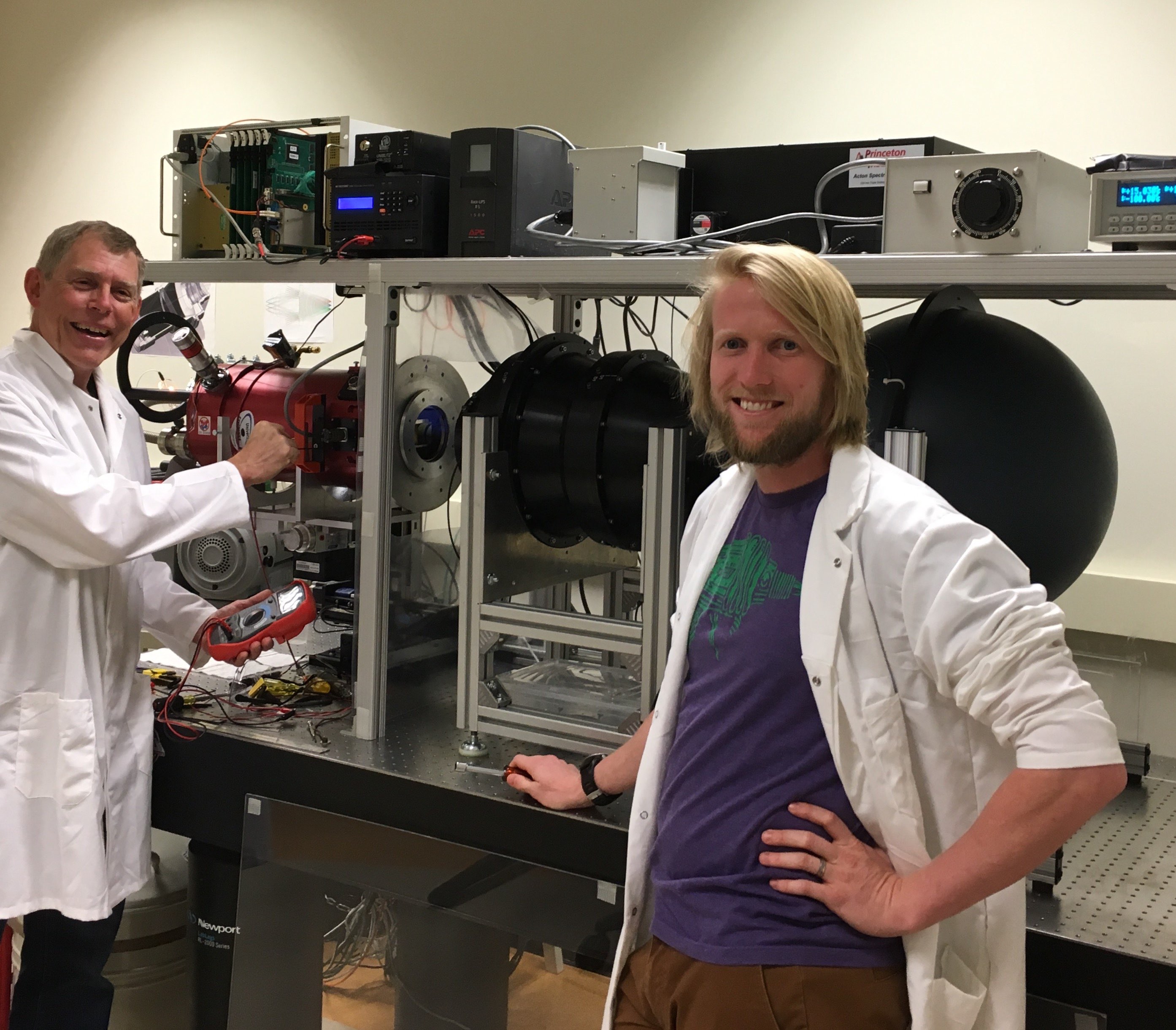
The system shown above is used to fully characterize the various systematic effects in our CCDs, from astrometric systematics, to the related PSF systematics, to the related photometric systematics -- all in the context of the resulting residual weak lens shear systematic error. Shown here are Craig Lage and Andrew Bradshaw. See arXiv:1703.05823. This R&D is key to the success of LSST as a dark energy physics mission. Its operations are a collaboration between our group, the LSST Project including the LSST Camera group at SLAC, and the Dark Energy Science Collaboration. Initially funded through an NSF AST ATI grant, the facility now is supported by private philanthropy and the DOE Office of High Energy Physics grant DE-SC0009999.
Dark Matter Fluctuations
The amplitude of dark matter clustering is a key cosmological parameter. Jee et al. found a normalization for the dark matter power spectrum which is slightly higher than previous estimates. One week later, the Plank team published a similar estimate. Our analysis used a new shear estimation algorithm applied to a million galaxies in the DLS in a 2-D analysis of shear-shear correlation vs angle.
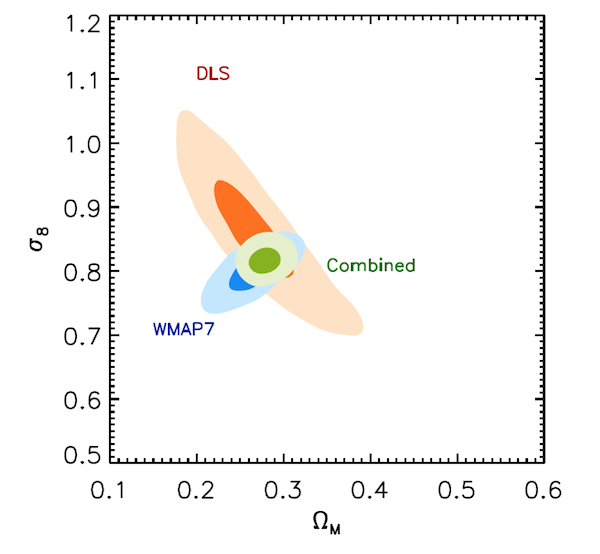
We have repeated this 2-D analysis with full cosmic shear tomography, making use of improved photometric redshifts and the new sFIT shear estimator. This yielded higher precision cosmology measurements: Jee et al. 2016 ApJ 824, 77. This estimator has recently been adopted for use by the Rubin Observatory LSST Data Management pipeline.
Growth of Large Scale Dark Matter Structure
Galaxies are embedded in dark matter over-densities, which should grow with cosmic time. Using weak gravitational lensing of a million galaxies of known redshifts in the Deep Lens Survey, Choi et al. were able to detect the growth of large scale mass directly for the first time. In the plot below, mass over-density associated with lens galaxies in three lens redshift bins (0.3, 0.5, 0.8) is shown as a function of projected radius from the galaxy. The observed growth in galaxy-mass correlation is consistent with LCDM cosmology, including galaxy bias.
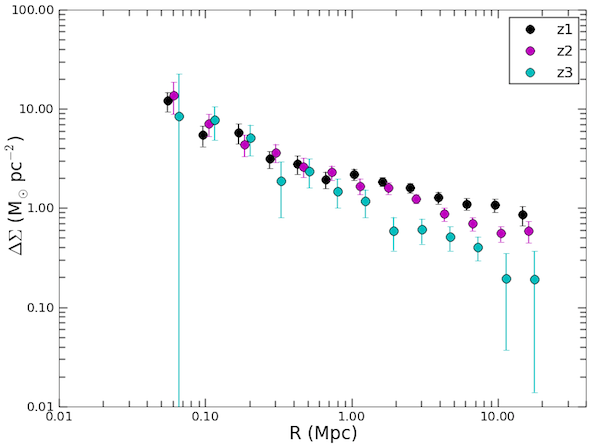
The next step is to fit a halo model to the data, informed by the galaxy clustering observed in each redshift bin. This will enable separation of bias from growth, and a more direct test of cosmology. Michael Schneider et al. are currently working on this, informed by covariance analysis of n-body simulations. With the LSST data, we expect 50x smaller errors! LSST will also probe the physics of dark matter in multiple ways.
Towards LSST Precision Photometric Redshifts
Sam Schmidt has been working on techniques to improve the calibration of photometric redshifts for LSST. As training data will likely be incomplete, particularly for the faintest galaxies, methods that can calibrate the redshift distribution with non uniform training data are of particular importance. The most promising technique takes advantage of the fact that galaxies are embedded in a cosmic web of large scale structure. In essence, if we have a set of objects for which we know the redshifts, even if such a sample is bright and not representative of the entire population, we can measure the cross-correlation signal between these known objects and an unknown sample to determine the redshift distribution of the unknown sample. In recent work we implemented such a technique, and showed that it can be extended into the quasi-linear regime of clustering to increase signal-to-noise, while still maintaining an accurate recovery of the redshift distribution. The figure shows a Gaussian redshift distribution drawn from mock galaxy light cones (blue) in only 300 square degrees in both a constant bias scenario (left), and galaxy bias evolving with redshift (right).
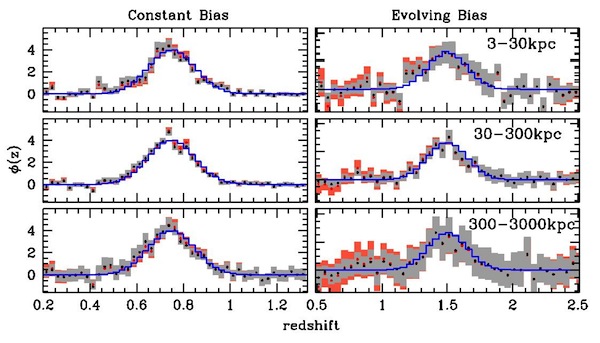
Shown: the raw estimated redshift distribution from our technique in red, as well as an additional correction in blue-grey, for 3 different clustering scales. The blue line is the true underlying redshift distribution. In all cases, we can accurately reconstruct the underlying distribution. Small scale cross-correlation measurements can also be used for sensitive tests for catastrophic outlier detection, which will be very important for LSST.
Laboratory search for dark photon dark matter
Many types of astronomical observations show decisively that most of the mass in the Universe is of an unknown form, unlike ordinary matter. This "dark matter" fills the universe and clumps over cosmic time under its own gravitational self attraction. Our current understanding of physics cannot explain dark matter; its existence is evidence for new physics! Its physical nature is a central unanswered question in science. Sensitive searches for weakly interacting massive particles in the GeV range have found nothing. Other possibilities for dark matter, such as the ultra-low mass nano eV to milli eV regime remain unexplored. A natural candidate for vector dark matter is the hidden photon, which can couple to electromagnetism. We are working on an extremely sensitive laboratory experiment: "Dark E-field Radio" which leverages cryogenic microwave detectors and FPGA technology in a GHz wide real-time spectral analysis. The result will be a 10,000-fold improvement over current astrophysical limits in dark matter detection searches in this vast unexplored ultra-low mass regime. Our group on this experiment is a collaboration between researchers in several departments at UC Davis and beyond. In 2021 we carried out a pilot experiment which demonstrated feasibility. See http://arxiv.org/abs/2101.02805 Recently we upgraded the experiment and set a new limit on the dark photon mass over the entire 0.2 - 1.2 micro eV range. https://doi.org/10.1103/PhysRevD.110.032010
New runs are in progress, going up to higher mass. This research is supported by the DOE, the Brinson Foundation, and the Nokia Foundation.
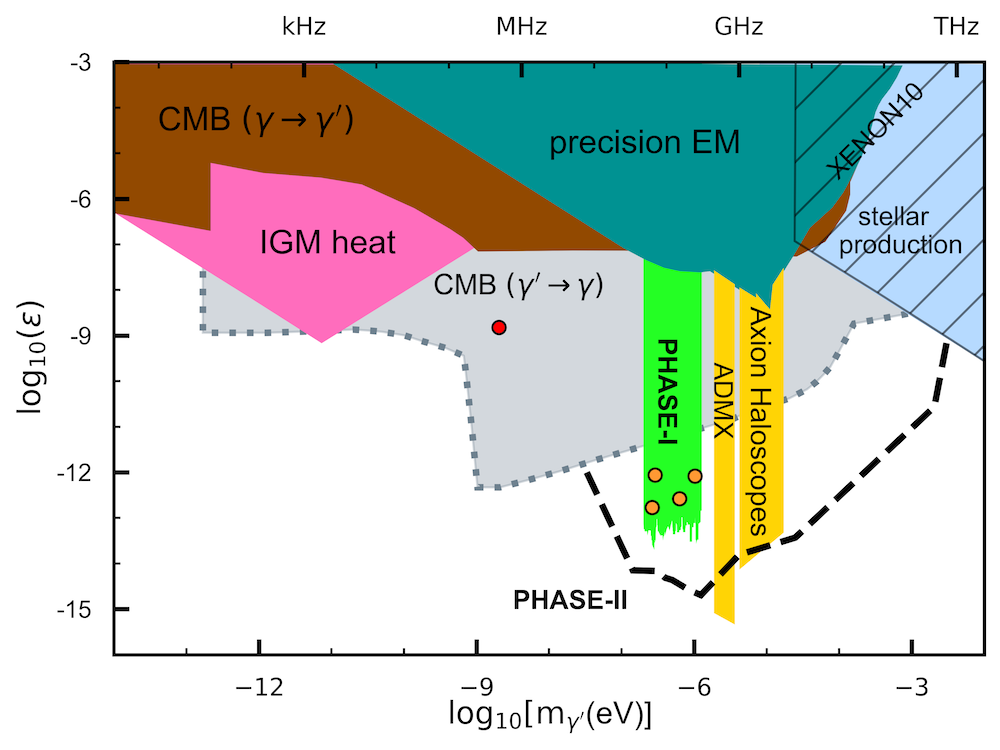
Projected reach of the Dark E-Field Radio experiment. The weak kinetic mixing factor is plotted vs dark photon mass. Regions excluded by astrophysics are shown. For reference, planned ADMX axion and hodoscope searches are shown in yellow. The orange points show calibrated exclusion regions at 4 spot frequencies at 5 sigma measured using the current pilot experiment. The red dot shows the point exclusion limit measured by Phipps et al. (2019). Phase-1 shows extrapolated limits using current setup after 1-year of real-time data acquisition. Phase-2 are cryogenic experiments covering the entire range 10 MHz -- 20 GHz, ultimately to THz.
